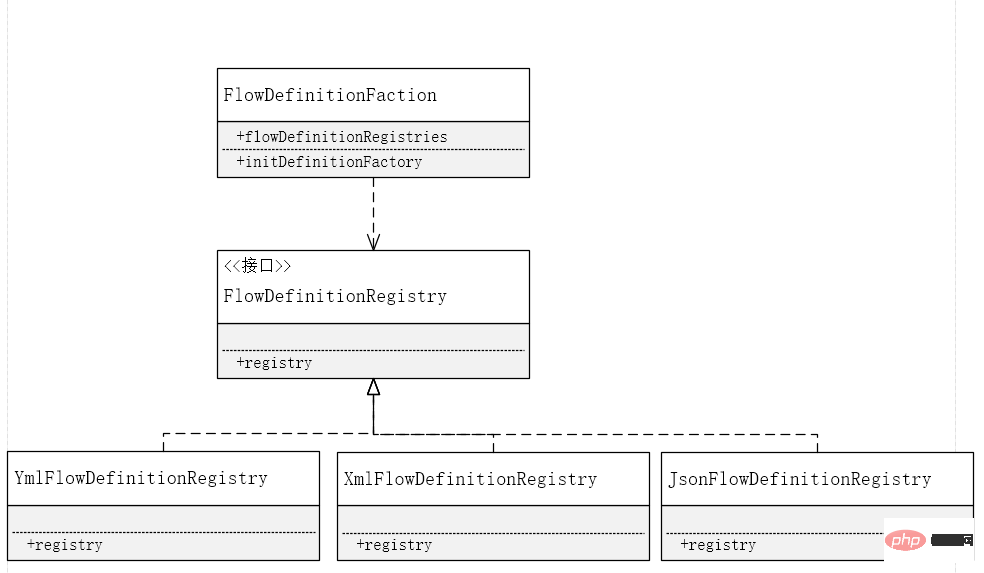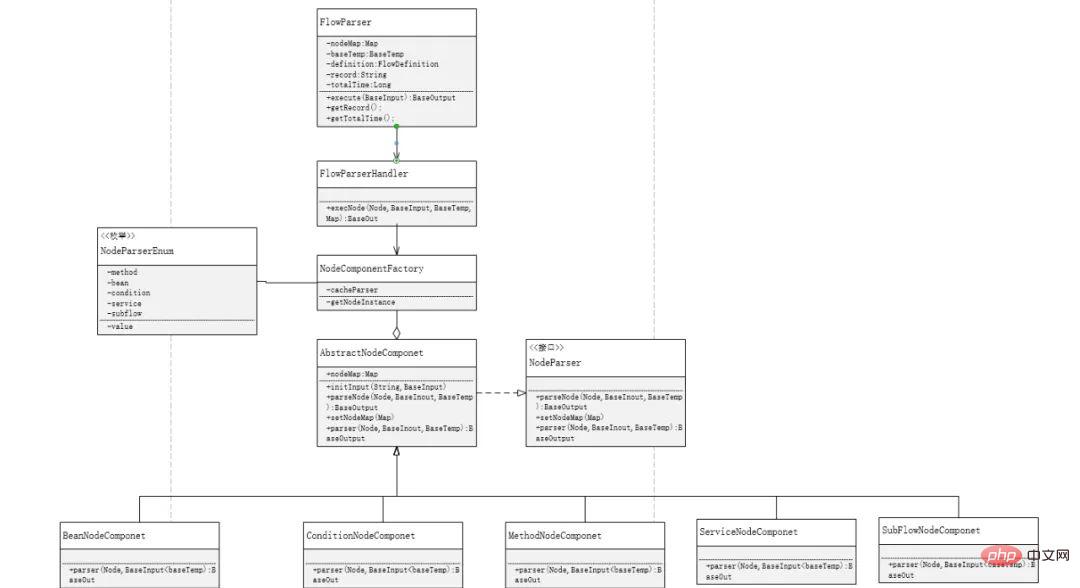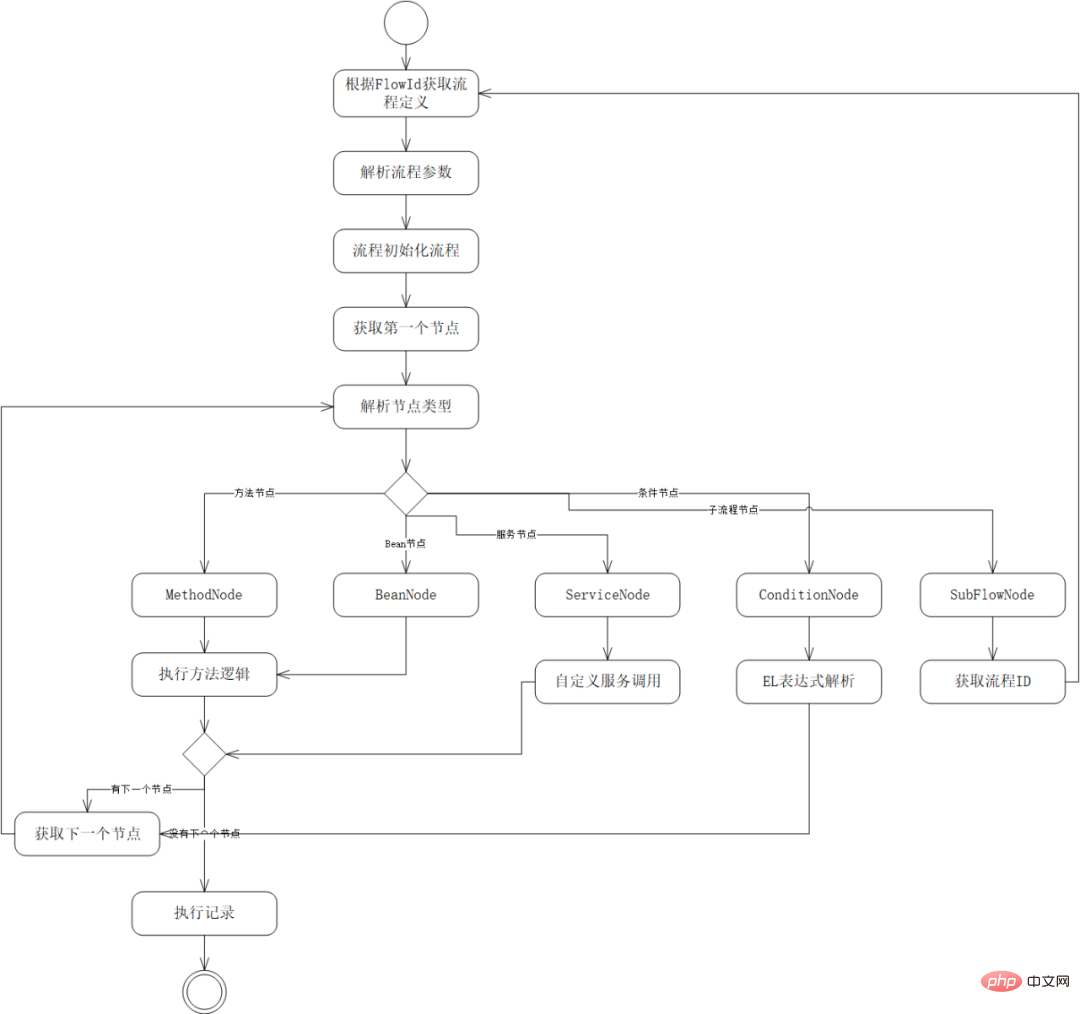How to implement a process orchestration framework in java
Process Registration
I mentioned before that we need to support the registration of process models in the form of yml, properties, xml, json, and interfaces. In order to reflect the Single Responsibility Principle, we need to use a format The parsing logic is processed independently. In order to reflect the principle of expansion development and modification closure , we first define a set of interfaces and then provide the corresponding implementation logic through the factory model; here the factory is Users call specific implementations through interfaces. The implementation here is the provider, which is also a set of strategy patterns.

Process Loading
Process Loading We need to know several other required function points: 1. Provide a unified external access interface; 2. Provide Execution records and execution time-consuming; 3. Different process nodes need to define different parsers; 4. Create parsing types through factories; 5. Process nodes are executed in order.

Perform different parsing methods through different node types. It is obvious that we need to use factory mode to create parsing classes, and we need to External expansion development is closed for modification. When adding nodes, you do not need to touch other code logic. You only need to add a node parser in the factory function; at the same time, we define a Map collection here to use the parsing object when loading the factory function. Create, instead of creating a parser every time you parse, to reduce unnecessary memory
The code is as follows:
<code>public class NodeComponentFactory {<br><br> private final static Map<string> cacheParser = new HashMap();<br><br> static {<br> cacheParser.put(NodeParserEnum.method.name(),new MethodNodeComponent());<br> cacheParser.put(NodeParserEnum.bean.name(),new BeanNodeComponent());<br> cacheParser.put(NodeParserEnum.condition.name(),new ConditionNodeComponent());<br> cacheParser.put(NodeParserEnum.service.name(),new ServiceNodeComponent());<br> cacheParser.put(NodeParserEnum.subflow.name(),new SubFlowNodeComponent());<br> }<br><br> public static NodeParser getNodeInstance(String nodeName){<br> return cacheParser.get(nodeName);<br> }<br>}<br></string></code>When we find that each node parsing type needs to implement parser interface, and each node has similar steps, then we must consider using an abstract factory here, which also conforms to the design principle of Dependency Inversion. The upper module is accessed through the dependency interface, and the next module inherits the abstraction class, and also used Strategy Pattern to make interface calls; in the logical process of implementation, we will find that many steps are repeated, such as initializing parameters and executing records, so we put the repeated content into abstract classes , through template mode, the process node only focuses on the parsing level;
<code>public abstract class AbstractNodeComponent implements NodeParser{<br><br> public Map<string node> nodeMap;<br><br><br> /**<br> * 初始化参数<br> * @param inputUrl<br> * @param baseInput<br> * @return<br> */<br> public BaseInput initInput(String inputUrl, BaseInput baseInput){<br> BaseInput baseInputTarget = ClassUtil.newInstance(inputUrl, BaseInput.class);<br> BeanUtils.copyProperties(baseInput,baseInputTarget);<br> return baseInputTarget;<br> }<br><br><br> /**<br> * 解析节点信息<br> * @param node 节点信息<br> * @param baseInput 请求参数<br> * @param baseTemp 临时上下文<br> * @return<br> */<br> public BaseOutput parserNode(Node node, BaseInput baseInput, BaseTemp baseTemp){<br> baseTemp.setFlowRecord(baseTemp.getFlowRecord().append(FlowConstants.NODEKEY+FlowConstants.NODE+FlowConstants.COLON+node.getId()));<br> BaseOutput baseOutput = parser(node, baseInput, baseTemp);<br> return baseOutput;<br> };<br><br> @Override<br> public void setNodeMap(Map<string node> nodeMap) {<br> this.nodeMap = nodeMap;<br> }<br><br> @Override<br> public abstract BaseOutput parser(Node node, BaseInput baseInput, BaseTemp baseTemp);<br><br>}</string></string></code>Process loading sequence
For process execution, we need to divide the components very finely, preferably A class that independently implements a function is divided into a component, embodying the single responsibility principle. Only by dividing the execution functions very finely can they be flexibly combined in each process of process execution; in the flow chart below, you can Seeing several components, the first one is the entrance for unified execution of the process. It will be used in two places. The first is the interface for external calls, and the second is the entrance for sub-process execution; the second component It is the node that loads the management component uniformly, which is the factory class mentioned above; the third is each component's own parser, which is used to implement the operation of different types of nodes; in the design process, you must know the relationship between process, management, and nodes. The boundaries between components reduce coupling, so that different components can be flexibly composed.

The above is the detailed content of How to implement a process orchestration framework in java. For more information, please follow other related articles on the PHP Chinese website!

Hot AI Tools

Undresser.AI Undress
AI-powered app for creating realistic nude photos

AI Clothes Remover
Online AI tool for removing clothes from photos.

Undress AI Tool
Undress images for free

Clothoff.io
AI clothes remover

Video Face Swap
Swap faces in any video effortlessly with our completely free AI face swap tool!

Hot Article

Hot Tools

Notepad++7.3.1
Easy-to-use and free code editor

SublimeText3 Chinese version
Chinese version, very easy to use

Zend Studio 13.0.1
Powerful PHP integrated development environment

Dreamweaver CS6
Visual web development tools

SublimeText3 Mac version
God-level code editing software (SublimeText3)

Hot Topics
 1387
1387
 52
52
 Perfect Number in Java
Aug 30, 2024 pm 04:28 PM
Perfect Number in Java
Aug 30, 2024 pm 04:28 PM
Guide to Perfect Number in Java. Here we discuss the Definition, How to check Perfect number in Java?, examples with code implementation.
 Weka in Java
Aug 30, 2024 pm 04:28 PM
Weka in Java
Aug 30, 2024 pm 04:28 PM
Guide to Weka in Java. Here we discuss the Introduction, how to use weka java, the type of platform, and advantages with examples.
 Smith Number in Java
Aug 30, 2024 pm 04:28 PM
Smith Number in Java
Aug 30, 2024 pm 04:28 PM
Guide to Smith Number in Java. Here we discuss the Definition, How to check smith number in Java? example with code implementation.
 Java Spring Interview Questions
Aug 30, 2024 pm 04:29 PM
Java Spring Interview Questions
Aug 30, 2024 pm 04:29 PM
In this article, we have kept the most asked Java Spring Interview Questions with their detailed answers. So that you can crack the interview.
 Break or return from Java 8 stream forEach?
Feb 07, 2025 pm 12:09 PM
Break or return from Java 8 stream forEach?
Feb 07, 2025 pm 12:09 PM
Java 8 introduces the Stream API, providing a powerful and expressive way to process data collections. However, a common question when using Stream is: How to break or return from a forEach operation? Traditional loops allow for early interruption or return, but Stream's forEach method does not directly support this method. This article will explain the reasons and explore alternative methods for implementing premature termination in Stream processing systems. Further reading: Java Stream API improvements Understand Stream forEach The forEach method is a terminal operation that performs one operation on each element in the Stream. Its design intention is
 TimeStamp to Date in Java
Aug 30, 2024 pm 04:28 PM
TimeStamp to Date in Java
Aug 30, 2024 pm 04:28 PM
Guide to TimeStamp to Date in Java. Here we also discuss the introduction and how to convert timestamp to date in java along with examples.
 Java Program to Find the Volume of Capsule
Feb 07, 2025 am 11:37 AM
Java Program to Find the Volume of Capsule
Feb 07, 2025 am 11:37 AM
Capsules are three-dimensional geometric figures, composed of a cylinder and a hemisphere at both ends. The volume of the capsule can be calculated by adding the volume of the cylinder and the volume of the hemisphere at both ends. This tutorial will discuss how to calculate the volume of a given capsule in Java using different methods. Capsule volume formula The formula for capsule volume is as follows: Capsule volume = Cylindrical volume Volume Two hemisphere volume in, r: The radius of the hemisphere. h: The height of the cylinder (excluding the hemisphere). Example 1 enter Radius = 5 units Height = 10 units Output Volume = 1570.8 cubic units explain Calculate volume using formula: Volume = π × r2 × h (4
 Create the Future: Java Programming for Absolute Beginners
Oct 13, 2024 pm 01:32 PM
Create the Future: Java Programming for Absolute Beginners
Oct 13, 2024 pm 01:32 PM
Java is a popular programming language that can be learned by both beginners and experienced developers. This tutorial starts with basic concepts and progresses through advanced topics. After installing the Java Development Kit, you can practice programming by creating a simple "Hello, World!" program. After you understand the code, use the command prompt to compile and run the program, and "Hello, World!" will be output on the console. Learning Java starts your programming journey, and as your mastery deepens, you can create more complex applications.




